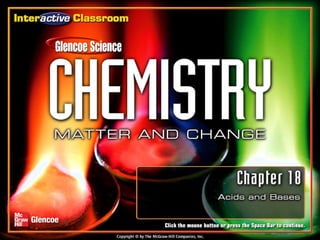Cmc chapter 18
•Download as PPT, PDF•
21 likes•7,063 views
This document provides an overview of key concepts about acids and bases from sections 18.1 through 18.4. It introduces the Arrhenius, Brønsted-Lowry, and Lewis models of acids and bases. It describes the properties of acids and bases and how pH and pKa/pKb values relate to acid and base strength. Neutralization reactions between acids and bases are discussed along with acid-base titrations and buffered solutions.
Report
Share
Report
Share

Recommended
Recommended
More Related Content
What's hot
What's hot (20)
Temperature and Kinetic Theory of Gases cheat sheet

Temperature and Kinetic Theory of Gases cheat sheet
Viewers also liked
Viewers also liked (20)
Similar to Cmc chapter 18
Similar to Cmc chapter 18 (20)
Chemistry - Chp 19 - Acids, Bases, and Salt - PowerPoints

Chemistry - Chp 19 - Acids, Bases, and Salt - PowerPoints
B sc_I_General chemistry U-II Ionic equilibria in aqueous solution 

B sc_I_General chemistry U-II Ionic equilibria in aqueous solution
B sc i chemistry i u ii ionic equilibria in aqueous solution a

B sc i chemistry i u ii ionic equilibria in aqueous solution a
More from Jane Hamze
More from Jane Hamze (17)
Recently uploaded
This slide is prepared for master's students (MIFB & MIBS) UUM. May it be useful to all.Chapter 3 - Islamic Banking Products and Services.pptx

Chapter 3 - Islamic Banking Products and Services.pptxMohd Adib Abd Muin, Senior Lecturer at Universiti Utara Malaysia
Recently uploaded (20)
UNIT – IV_PCI Complaints: Complaints and evaluation of complaints, Handling o...

UNIT – IV_PCI Complaints: Complaints and evaluation of complaints, Handling o...
Benefits and Challenges of Using Open Educational Resources

Benefits and Challenges of Using Open Educational Resources
Industrial Training Report- AKTU Industrial Training Report

Industrial Training Report- AKTU Industrial Training Report
Chapter 3 - Islamic Banking Products and Services.pptx

Chapter 3 - Islamic Banking Products and Services.pptx
1.4 modern child centered education - mahatma gandhi-2.pptx

1.4 modern child centered education - mahatma gandhi-2.pptx
Salient features of Environment protection Act 1986.pptx

Salient features of Environment protection Act 1986.pptx
Welcome to TechSoup New Member Orientation and Q&A (May 2024).pdf

Welcome to TechSoup New Member Orientation and Q&A (May 2024).pdf
Sectors of the Indian Economy - Class 10 Study Notes pdf

Sectors of the Indian Economy - Class 10 Study Notes pdf
Danh sách HSG Bộ môn cấp trường - Cấp THPT.pdf

Danh sách HSG Bộ môn cấp trường - Cấp THPT.pdf
Overview on Edible Vaccine: Pros & Cons with Mechanism

Overview on Edible Vaccine: Pros & Cons with Mechanism
Cmc chapter 18
- 2. Chapter Menu Acids and Bases Section 18.1 Introduction to Acids and Bases Section 18.2 Strengths of Acids and Bases Section 18.3 Hydrogen Ions and pH Section 18.4 Neutralization Exit Click a hyperlink or folder tab to view the corresponding slides.
- 4. Section 18-1 Section 18.1 Introduction to Acids and Bases (cont.) acidic solution basic solution Arrhenius model Brønsted-Lowry model conjugate acid Different models help describe the behavior of acids and bases. conjugate base conjugate acid-base pair amphoteric Lewis model
- 20. End of Section 18-1
- 22. Section 18-2 Section 18.2 Strengths of Acids and Bases (cont.) strong acid weak acid acid ionization constant strong base weak base base ionization constant In solution, strong acids and bases ionize completely, but weak acids and bases ionize only partially.
- 32. End of Section 18-2
- 42. End of Section 18-3
- 44. Section 18-4 Section 18.4 Neutralization (cont.) neutralization reaction salt titration titrant equivalence point In a neutralization reaction, an acid reacts with a base to produce a salt and water. acid-base indicator end point salt hydrolysis buffer buffer capacity
- 46. Section 18-4 Reactions Between Acids and Bases (cont.)
- 50. Section 18-4 Reactions Between Acids and Bases (cont.)
- 63. End of Section 18-4
- 64. Resources Menu Chemistry Online Study Guide Chapter Assessment Standardized Test Practice Image Bank Concepts in Motion
- 79. IB Menu Click on an image to enlarge.
- 80. IB 1
- 81. IB 2
- 82. IB 3
- 83. IB 4
- 84. IB 5
- 85. IB 6
- 86. IB 7
- 87. IB 8
- 88. IB 9
- 89. IB 10
- 90. IB 11
- 91. IB 12
- 92. IB 13
- 93. IB 14
- 94. IB 15
- 95. IB 16
- 96. CIM Table 18.2 Three Models for Acids and Bases Table 18.3 Ionization Equations Figure 18.20 A Neutralization Reaction Figure 18.21 Titration Figure 18.22 Neutralization Reactions
- 97. Help Click any of the background top tabs to display the respective folder. Within the Chapter Outline, clicking a section tab on the right side of the screen will bring you to the first slide in each respective section. Simple navigation buttons will allow you to progress to the next slide or the previous slide. The “Return” button will allow you to return to the slide that you were viewing when you clicked either the Resources or Help tab. The Chapter Resources Menu will allow you to access chapter specific resources from the Chapter Menu or any Chapter Outline slide. From within any feature, click the Resources tab to return to this slide. To exit the presentation, click the Exit button on the Chapter Menu slide or hit Escape [Esc] on your keyboards while viewing any Chapter Outline slide.
- 98. End of Custom Shows This slide is intentionally blank.